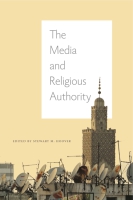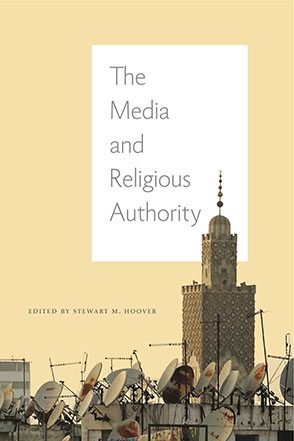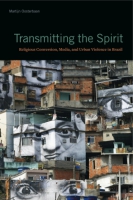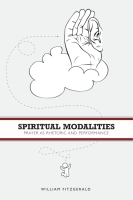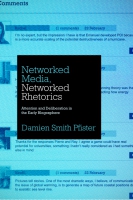The Media and Religious Authority
Edited by Stewart M. Hoover
“A fascinating mélange of essays, and a versatile collection that could be utilized in a variety of settings.”
- Description
- Reviews
- Bio
- Table of Contents
- Sample Chapters
- Subjects
An insightful combination of theoretical groundwork and individual case studies, The Media and Religious Authority invites us to rethink the relationships among the media, religion, and culture.
The contributors are Karina Kosicki Bellotti, Alexandra Boutros, Pauline Hope Cheong, Peter Horsfield, Christine Hoff Kraemer, Joonseong Lee, Alf Linderman, Bahíyyah Maroon, Montré Aza Missouri, and Emily Zeamer, with an afterword by Lynn Schofield Clark.
“A fascinating mélange of essays, and a versatile collection that could be utilized in a variety of settings.”
“If you, like me, are fascinated by the often baffling relationship between media, religion, and authority, then Stewart Hoover’s book is a must-read. Often, authority is assumed to be held by institutions. Hoover argues against this by weaving together diverse case studies into a cutting-edge theoretical perspective that illustrates how authority is constituted by lived media practices. Clearly written and insightful, The Media and Religious Authority brings together the minutiae of everyday lived religion with an overarching vision that only one of the leading scholars in the field could achieve.”
“How do contemporary media challenge religious authority? The answer to this question is not as straightforward as it might appear. The contributors to this volume examine how the media undermine established religious positions and help reshape the concept of ‘the religious’ as well as the forms of authority. This is such a transformation that one may indeed conclude, as Stewart Hoover does, that religion today is being remade by the media.”
“This brilliant book shows a master editor at work. It identifies and gives substance to the critical issue of religious authority in the global media age in terms of its constitution. The book knows intellectual history; it understands the classics and their relevance today as it opens pathways to the future. Rarely is one book erudite in theory and also sophisticated in research methodology, but The Media and Religious Authority is a model of both. This is scholarship of the world mind; the case studies span the continents, and the theorizing represents the big picture.”
Stewart M. Hoover is Professor of Media Studies, Professor Adjoint of Religious Studies, and Founder and Director of the Center for Media, Religion, and Culture at the University of Colorado, Boulder. His most recent book is Religion in the Media Age.
Contents
Acknowledgements
Introduction: The Media and Religious Authority Stewart M. Hoover
Section One: Re-thinking authority in an era of media and religious change
Religious Authority in the Media Age Stewart M. Hoover
The Media and Religious Authority from Ancient to Modern Peter Horsfield
Media and (vicarious) religion – two levels of religious authority Alf Linderman
Religious Authority & Social Media Branding in a Culture of Religious Celebrification Pauline Hope Cheong
Section Two: Case Studies
Satellite Publics: Moral Identity and New Media in Moroccan Islam Bahíyyih Maroon
Examining all the Realms of Nature: Evidence, insight, and the quest for knowledge in modern Thailand Emily Zeamer
Cyber Memorial Zones and Shamanic Inheritance in Korea Joonseong Lee
Baadaass Mamas: Race, Sex and Afro-Religiosity in Sankofa Montré Missouri
Techno-Vodou: Transnational Flows in the Spiritual Marketplace Alexandra Boutros
Evangelical Media for Youth and Religious Authority in Brazil Karina Kosicki Belotti
The Authority of the Image: Sex, Religion, and the Text/Image Conflict in Craig Thompson’s Blankets Christine Hoff Kraemer
Afterword Lynn Schofield Clark
Notes
Bibliography
Index
INTRODUCTION
Stewart M. Hoover
The Twenty-First Century dawned with dramatic changes in relations between long-standing sources of social and cultural power and meaning. The ongoing processes of globalization, both in its economic and cultural forms, have reorganized and reoriented relationships between peoples and nations. These forces of change have served both to reify particular expressions of culture and politics and to place those expressions within larger contexts of competition, struggle, and—potentially—accommodation and re-orientation.
Within these processes, nothing has exerted itself to more effect (and in a way, surprise) than religion. For most of the last Century, it was convenient—particularly in the West—for intellectual, social, and cultural authorities to overlook religion as a force in society, culture, and politics—both domestically and internationally. Against this, religion began to rise in importance in the last decades of the Century through such events as the Islamic Revolution in Iran and the emergence of Evangelical politics in the U.S.
The events of 9/11 of course raised the profile of religion to an entirely new level. In the years since, lay and scholarly discourses have struggled to contend with the persistence of religion as a force in domestic and global politics and society. This renewed attention to the place of religion has led to its discovery all around us, in places and in registers that are both emergent and persistent but previously overlooked. We can see that religion is now both local and global, that its presence is felt in national political contexts as well as in transnational culture and politics. We can also see that there is reason to ask whether evidence of the resurgence of religion is instead evidence of its persistence in new forms, particularly in settings beyond the formal domains of discourse: in such places as popular and entertainment cultures.
Implicit in all of this are two issues that are fundamental to understanding religion and its role in politics and society in the new century. The first of these is the important role that the media and the mediation of religion, religious symbols, and religious experience have come to play in the resurgence of religion. The second is the question of religious authority. To the extent that new forms and contexts of religious identity and practice are emerging, the traditional sources of religious symbols, truth claims, and meanings find themselves in competition with these new and emergent ones. But the relationship between emerging mediations of religion and religious authority is not simple or straightforward. It is complex, layered, and nuanced, and it is the purpose of this volume to describe it in these terms.
Media are clearly at the center of many of these developments in the world of religion. This is obvious in formal media settings such as journalism, where religion "coverage" is on the increase, though it is still contested and troubled turf. It is also obvious in the production and distribution of specifically "religious" media by religious bodies, which is also growing in volume and significance worldwide. But the media play an important informal role as well. The Iranian revolution, for example, relied heavily on the “small media” of cassette tapes for the spread of its ideas. Iran’s “Green Revolution” following the 2009 elections there and the “Arab Spring” protests of 2011 centered media as well, though this time the digital “new media.” The Evangelical revival in the U.S. was in great measure a function of its mediation via such forms as Televangelism and other kinds of para-institutional, commodified popular culture, including Christian music, religious films and the religious publishing industry.
Religion has also become more and more a feature of the so-called “secular” entertainment media, from television programs such as Touched by an Angel, to Oprah, to Battlestar Galactica, to My Name is Earl, to theatrical films such as Ghost, Bruce Almighty, Avatar, and the Twilight series, to the recording industry. A growing literature considers how such things might have a role to play in constructing contemporary religion.
To the extent that the media are becoming more important in these ways, there are clearly implications for religious authority. Some of these implications are obvious, some less so. It is obvious that the media today directly confront religious authorities’ ability to control their own symbols and symbolic resources. Mediations of symbols such as the crucifix (in the case of Madonna’s classic Like a Prayer video) de-link legitimated and authoritative readings of those signs from the signs themselves. Media also confront authority through the sheer number and range of mediations of religious and quasi-religious imbrications and truth claims that circulate in contemporary media contexts. This potentially serves to dissolve the boundaries of the discursive settings (religious observances, religious instruction, etc.) where religion has been legitimately talked about. Global media further confront authority by relativizing it, bringing a wider range of religious symbols, discourses, and claims to the attention of global publics. Thus, in any local context there is today at least the possibility that the local “gods” must now be seen alongside gods from a wide range of other contexts, both national and global.
It is a straightforward matter to see these things in institutional or structural terms. The media industries are widely understood today to be important actors on the national and global stage. They confront political authorities as readily as they do religious ones. Global corporate media are even claimed in some circles to constitute an extra-national or meta-state political force. Governments treat media as competitors and threats, and often move to control them when and where they can. Thus it makes some sense to see media in relation to religious authority in similar ways. Religious leaders seek opportunities for “air time” to promote their views in broadcast media (such as the Tim Tebow pro-life commercial in the 2011 American Football game the Superbowl). Certain films are seen by—and criticized by—certain religious authorities in terms of their direct challenge to official readings of doctrine or history (as in the Vatican’s criticisms of The DaVinci Code and Avatar). Religious leaders have of course also sought to create or own “media.”
Thinking of these relations in structural terms alone, however, overlooks a much more varied, layered, and complex landscape of interactions between various levels of “lived” religion and “lived” and “consumed” media. In recent decades, media theory has evolved away from an orientation to formal media structures and their productions and toward an appreciation for the way that popular reception practice can and does make its own meanings out of media. As a field, culturalist media studies has stressed these “meanings made,” and has contemplated media and media contexts beyond the formal realms of journalism and broadcasting. This has meant that the so-called “popular” and entertainment media—across a range of platforms and channels—are seen to be of increasing importance in the construction of cultural and social meanings and effects. The diversification and fracturing of sources and channels in the digital age has made it even more important to think of media in other than purely institutional-structural terms
This is made even more pressing in an era of cultural globalization, where the circulation of meanings and values is ever more widespread, diverse and interactive. The very grounds on which mediations of religious and quasi-religious imaginaries and claims might be encountered and understood are shifting. New insights, new truth claims, new symbols, and new practices today can come from across the world as readily as from across the street. And, insights into relations between media, religion, and culture can be gained from attention to specific cases and contexts from across the globe.
It should be clear then that we need to think about media, about religion, and about authority in new ways. This re-thinking would need to address at least the following issues:
1) The overall question of religious change and transformation. I am arguing that Religion is today being remade by media. This moves beyond the straightforward notion that all religions are mediated and that modern media introduce new ways that religions are understood and practiced. Instead, there is a growing discourse, such as that in the theoretical domain known as “mediatization theory,” that suggests that the outcome of the interaction between religion and media is the creation of something entirely new: a difference in kind, not merely in scale.
2) This difference is expressed along a number of dimensions, but perhaps none is more important than that contemporary media increasingly make it possible for new religious forms and—in particular new religious voices—to emerge. This has two further implications. First, the particular claims, values, and symbols these new voices articulate become part of the discourse of religion. Second, by virtue of their actions, these new voices can build networks and solidarities, and potentially achieve some form of authority on their own.
3) Thus these processes raise the question of the locus and constitution of authority. Traditional authority continues, of course. But it is now joined by other centers and contexts of authority. And these new centers and contexts are of course not unproblematic. We might be interested in the first instance in how they provide a challenge to prior centers of power in religion, but they themselves may then become subject to similar challenge and are certainly deserving of similar critique and analysis.
4) Authority in these regards is often linked to debates over authenticity. The received view is that this is a necessary linkage, that authority must maintain its control for the sake of authenticity in relation to symbols, practices, texts, and doctrines. A more nuanced view, and one more cognizant of critical post-structuralist notions, would suggest that this is an issue of power. The power to assign things to the category of “the authentic” is the primary power religious authorities hold, and their claim of this power is their necessary currency of exchange. Critical reflection on this as a discourse of power is thus a central task.
5) This is all not just a question of structural relations and of power as expressed through structure. It cannot be ignored that new forms of mediation are at their base aesthetic processes linking practice and identity with such things as taste and sensation. These aesthetic sensibilities and saliencies are of course important in terms of the reception of various media forms, but it can also be argued that sensation and taste can also help constitute identities, communities, and movements. Received approaches and understandings have under-valued the aesthetic and sensational, just as they have the popular and informal. To the extent that religious persistence or resurgence was overlooked prior to the late 20th or the turn of the 21st Century, this bias toward formal and structural expressions of religion may have been one of the reasons.
This volume is intended to open up the task of rethinking these matters. It does so in two sections. An initial set of chapters revisits the question of authority in relation to these evolving senses of “the religious.” Taking onboard received ways of understanding authority and the application of those understandings to the question of religion, they broaden and deepen the grounds on which we might look at the larger implications of new mediations of religion for the sources and centers of legitimation within and beyond religious structures. Classical understandings of authority—rooted in Weber’s ideas—are in need of serious and careful reflection as they might be applied to modern religion, to modern media, and to modern mediations of religion and spirituality.
Following this, the book then moves in a second section to a series of grounded case studies across a range of cultural, geographic, and religious contexts. They are in-depth, observational, textual, and ethnographic studies of particular instances of media production and reception in Asia, Africa, Latin America, and North America. Some involve formal representations of religion and spirituality. Some involve informal and emergent, even resistive articulations and voices. Some demonstrate clear demarcations between established authority and contexts of practice, others blur those lines. In some, the sources of textual and other meanings clearly reside within formally constituted religious contexts. In others, the media themselves seem to be the sources of these things. Some revolve around formal mediation by large-scale media such as film and television, others are generated by new, social, interactive, and “small” media such as Twitter. Each demonstrates the value of this sort of grounded study as they provide valuable insights in to the ways that the elastic relations between religion and media are being shaped today in a variety of settings. Importantly, together they also provide an international, even global view.
In the first chapter, I assess the moment theoretically, looking at the foundational conception of authority found in the classic work of Max Weber. Weber’s ideas of the nature of authority and types of authority underlies much of what we now think of in relation to religious authority. In fact, religion has seemed to be particularly implied in his category of “traditional authority.” Weber’s thoughts about the constitution of authority are also influential, and remain apt and perhaps even more significant today as the traditional grounds and boundaries of authority seem to be shifting. That part of the reason for this shift seems to be attributable to modern media and the contemporary media sphere frames much of what we consider here.
Weber persuasively argues that most valences of authority rest on structures of plausibility. To be legitimate, authority must be perceived to be plausible, valid and (to an extent) authentic. Regardless of whether it is legal, traditional, or charismatic authority (Weber’s fundamental categories) it must be articulated to belief among its objects in order to retain its power. The significant frame of modern public life makes this plausibility problematic, rather than taken-for-granted. This frame includes the situation in the developed West, where publics today are increasingly resistant to authority and express declining confidence in the important institutions of public life. Elsewhere, particularly in Africa and the Middle East, confidence in politics is still a work-in-progress. Fundamental socio-structural issues also come into play. Anthony Giddens (1992), for example, has laid out an articulate argument about modern consciousness, in which he suggests that in contemporary life, individuals increasingly engage with the structures of social life reflexively and with a consciousness of the means and sources of the structural conditions of their lives.
None if this is, of course, absolute, but Giddens’s argument here is instructive, especially as regards questions of the large role of media in these conditions. A good deal of this reflexive autonomy (the power that individuals today seek to exercise over their own senses of self and identity) is articulated with a mediated public sphere that makes systems of power and the structures of power more obvious, at least notionally. The media contribute to a situation where individuals feel that they have “…seen behind the curtain…” of the nature and constitution of power and authority, making that authority less tacitly plausible. This condition impinges state authority of course, but also has important implications for religious authority. Within this frame, where the media establish large conditions within which religion (and presumably religious authority) must function, we can see many smaller and more conditional contexts of action. The studies here detail such contexts and phenomena, painting a picture of practices that make religious authority problematic in large and small ways and on a variety of levels.
To look at the implications in more detail, we can think about how each study here relates to the Weberian structure of authority outlined in the first chapter. There, I argue that questions of the mediation of religion impinge on Weber’s categories in different ways and to different extents. My argument there is general, becoming more obvious as we look at specific cases. But, on that general level, it might be argued that of the Weberian categories, legal authority might well be least implied by the work we see here. Far more implied is the category of traditional authority, which was also more obviously connected to religion even in Weber’s thinking. To review, traditional authority receives and maintains its position through its embedment in, and appeals to, shared history and received tradition. This more cultural ground of authority might logically be more implied in the sorts of cultural practices seen in these chapters. These studies and these contexts vary in the constitution of tradition and authority in each, but what ties them together is the way that in each case, tradition is confronted, at least in cultural terms.
Weber’s third type of authority, charismatic authority, is also implied here, along a number of dimensions. First, there is the broad consensual sense that the media, particularly commercial media, establish their own authority by means very much like Weber’s charisma: it is based on their attractiveness to audiences more than it is on traditional or structural means. Charismatic authority is also implied to the extent that the specific practices of mediation that we will see are more symbolic, less material, something that also evokes Weber’s charisma. The connection to this type of authority is also obvious in some of the controversy that surrounds the assignment of some of the practices we see here to the category of “religion.” On an important level of received validity, they can appear to be superficial, transitory and ephemeral, as opposed to the received idea of religion as historic and unchanging. This means that, to the extent that the kinds of things we see here become more commonplace articulations of religion, the whole meaning of religious authority may be shifting, away from structure, and toward practice. Such a claim, of course, is very much a commonplace in contemporary religious studies.
Thinking in terms of charismatic authority also re-frames the debates around some received ideas about the media themselves. What is possible in media and in practices of audiences and communities in relation to media is in part conditioned and framed by our consensual understandings of, and valuation of, media. On a large and public level, certain kinds of media re preferred over others (by authorities!). The received view of media has been articulated by cultural voices such as Daniel Boorstin (1992) who decried “the triumph of the image in America.” We take for granted that the media traffic in superficiality and when compared to traditional or legal authority, authority rooted in charisma might easily be thought of as more superficial, less significant, less serious, and necessarily less authentic.
Against these assumptions about charismatic authority in relation to the media, there are contrasting implications from two directions. First, we might suggest that the Weberian notion of plausibility in charismatic authority might well suffer or at least be contested by a linkage through media with markets, market competition, and the presumed superficiality of such things as the “commodification” of religion through its absorption into commercial and commodity markets. A second direction might suggest that this new situation might put the whole question of plausibility in a new light, that the marketing of religious charisma might actually legitimate some sources as authoritative more convincingly because of the functioning of these cultural markets. These are two sides of the same coin, seeing as a problem the diminution of the ostensibly “authentic” on the one hand and seeing that very process as one that establishes legitimacy and authenticity on the other.
This is the sort of larger question that this book hopes to address. It is illustrative that the media age as it were “opens up” such questions. In this case, and across the cases we consider here, it is a refiguring of Weber’s fundamental categories of traditional and charismatic authority that is at issue. The question of the mediation of religion through these contemporary practices repositions the grounds of Weber’s theory. Whereas to Weber the issue if “plausibility” was a prior condition for the functioning of his types of authority, we now know, (through the work of Habermas, at least) that in the contemporary public sphere(s), plausibility is actually in play, a dimension whose variation becomes a constitutive condition of authority, a dimension along which negotiations of the status of authority might take place. The question might not be so much whether specific centers of hermetic authority have achieved plausibility as a pre-condition to their status or influence, but rather how the plausibility of various authorities or authoritative claims or voices, once achieved, constitutes their authority.
The second category in question, “traditional authority” in religion, is also in play in a different way than suggested by Weber. Like Durkheim and Tönnies, Weber worked from a received history of religion which saw religious tradition, and its authority, in structural and essentialized terms. Specific religions, and their systems of authority, were known entities with clearly-demarcated and known sources and histories, and their meaning and effect could be measured against those things. Thus a key consideration is whether a given utterance or practice or process is consistent with the legacy of history.
The cases we see here invite us to think of things differently. Instead of thinking of authority inductively, in terms that assume its constitution and efficacy, seeing new conditions in terms of their variation on, or challenge to, that efficacy, we must now think of authority in terms of its constitution. Where does it come from? How is it established? Who is involved? Who or what might be challenging or changing it? In these pages, we will see that the implications for authority fall out along three general lines.
First, it is apparent that the practices and functioning of these “markets” have great potential to differentiate religions. They illustrate and illuminate various religious resources, symbols, structures and claims, placing them in a more-or-less horizontal marketplace of choice (Cf. Hoover, 2006). The very fact that these various sources are placed alongside others in this context further demands distinctiveness, thus even further differentiation. Religions in the modern media marketplace then become at least in part a highly refined and almost iconic version of themselves.
Second, these relativized sources of religion are then relativized by their positioning in the marketplace. As religions are presented within the various public and mediated frames, they appear alongside one another. This almost by definition suggests that none has a necessary precedence over the others. None is more important than the others, except as it achieves increased definition and influence through practice.
Third, these sources, to the extent that some surface above the others, must well do so through some form of Weber’s “charisma.” They must find their place and their voice through means that are outside the bounds of history and structure. The very fact that we think of this as a “marketplace” almost by definition implies that some version of Weber’s charisma must be involved.
This all serves to turn around the traditional and received ideas about authority. Rather than flowing from sources in doctrine and history, and therefore from some essentialized notion of “the religious,” I would argue that what we see in these pages suggests that authority instead flows from the “other end” of Weber’s chain of causation. It is in what he called “plausibility” that the examples we see here draw their force in relation to authority and therefore achieve new and nuanced authority of their own. These are new and emergent centers and sectors of authority, rooted in their ability to find audiences, to plausibly invigorate or invite practice, and to direct attention. In each case, we see these processes, but we often see them in formation and in the early stages of their evolution. These are primarily cases that involve “something new:” a new trend, a new context, a new medium, a new social or discursive project. Thus the final significance of what we see here is in what it can tell us about where and how practices and meanings of authority will evolve. We can infer some things from these cases about how things are working now, but we can also begin to see where they might go next.
This new Century has invited a large-scale re-thinking of “the religious,” as I have said. Religion has persisted. It has persisted in part due to modern mediation and the infusion of religion into contexts of—and its use of—means of contemporary mediation. These chapters help us shape and nuance our view of how these things work. They are not all about formal or institutional or technological mediation. Some are about small, local, and informal things. Some deal with means of mediation far removed from the sophisticated “mass media.” Some involve the efforts of purposive actors. Others are more casual and emerge out of broader structures of practice. Each of them, though, tells us that we need to be thinking about the ways that contemporary contexts and practices of mediation make the prospects of religious authority increasingly complex, nuanced, and layered.
This book is only a first step in such a process of thinking and re-thinking. It invites further discussion and even debate. More importantly, it invites more empirical work. The projects reported here are only a few of the possible themes and approaches and methods that might be used. The authors here join me in inviting others to address this work by building on it, contesting it, refining it, and enhancing it through scholarship. We do hope that we’ve started a conversation that will continue for some time to come.
Also of Interest
Mailing List
Subscribe to our mailing list and be notified about new titles, journals and catalogs.
